当代国外翻译理论导读
当代西方翻译理论(范文)
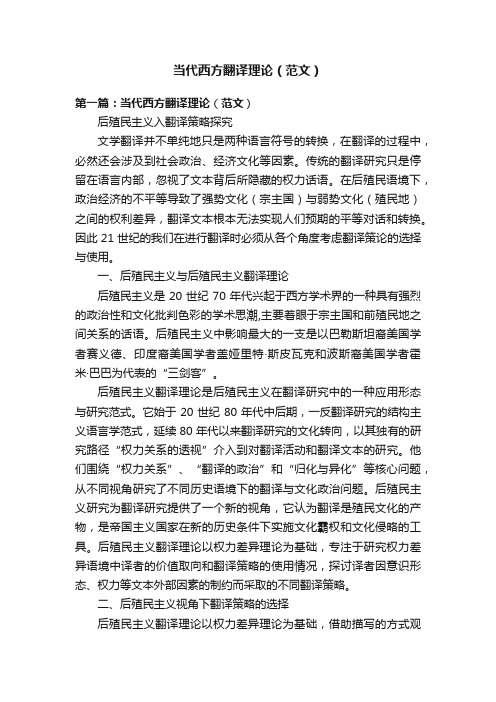
当代西方翻译理论(范文)第一篇:当代西方翻译理论(范文)后殖民主义入翻译策略探究文学翻译并不单纯地只是两种语言符号的转换,在翻译的过程中,必然还会涉及到社会政治、经济文化等因素。
传统的翻译研究只是停留在语言内部,忽视了文本背后所隐藏的权力话语。
在后殖民语境下,政治经济的不平等导致了强势文化(宗主国)与弱势文化(殖民地)之间的权利差异,翻译文本根本无法实现人们预期的平等对话和转换。
因此21世纪的我们在进行翻译时必须从各个角度考虑翻译策论的选择与使用。
一、后殖民主义与后殖民主义翻译理论后殖民主义是20世纪70年代兴起于西方学术界的一种具有强烈的政治性和文化批判色彩的学术思潮,主要着眼于宗主国和前殖民地之间关系的话语。
后殖民主义中影响最大的一支是以巴勒斯坦裔美国学者赛义德、印度裔美国学者盖娅里特·斯皮瓦克和波斯裔美国学者霍米·巴巴为代表的“三剑客”。
后殖民主义翻译理论是后殖民主义在翻译研究中的一种应用形态与研究范式。
它始于20世纪80年代中后期,一反翻译研究的结构主义语言学范式,延续80年代以来翻译研究的文化转向,以其独有的研究路径“权力关系的透视”介入到对翻译活动和翻译文本的研究。
他们围绕“权力关系”、“翻译的政治”和“归化与异化”等核心问题,从不同视角研究了不同历史语境下的翻译与文化政治问题。
后殖民主义研究为翻译研究提供了一个新的视角,它认为翻译是殖民文化的产物,是帝国主义国家在新的历史条件下实施文化霸权和文化侵略的工具。
后殖民主义翻译理论以权力差异理论为基础,专注于研究权力差异语境中译者的价值取向和翻译策略的使用情况,探讨译者因意识形态、权力等文本外部因素的制约而采取的不同翻译策略。
二、后殖民主义视角下翻译策略的选择后殖民主义翻译理论以权力差异理论为基础,借助描写的方式观察、研究和解释权力差异语境中译者自觉与不自觉的价值取向和策略选择。
用它的相关理论对归化、异化、杂合化翻译策略进行分析。
当代国外翻译理论导读第六章女性主义翻译理论
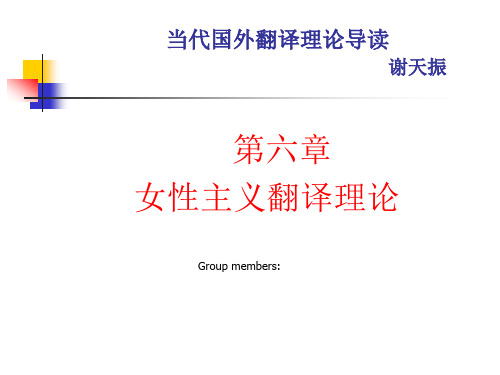
执教于加拿大Concordia University,翻译理论家,文 化专家 Works: 《翻译中的性别:文化身份和传播的政治》 (Gender in Translation: Cultural Identity and the Politics of Transmission, 1996)是她的重要译学理论专著之一,也 是西方第一本全面论述女性主义视角下的翻译问题的 学术性专著。《语言的交流》、《分裂城市中的间奏 曲:翻译蒙特利尔》 主要从事翻译理论与文学研究,探讨作为政治与文学运 动的女性主义对于翻译理论和实践的影响。
Main Points
翻译和女性从传统上看,都处于弱势和低等位置,译者是作者的侍 女,女人是男人的侍女。这一不平等的伙伴关系及其象征意义,催 生了翻译与女性思潮的关联。 女性差异的三个阶段: ①本质主义阶段:在本质上存在“女性的现实性”,与父权相对 ②差异的存在是历史上通过语言和文化环境形成的建构主义模式, 女性的现实性通过社会产生 ③女性的差异由种族、阶级和民族等文化压力形成
Main points
劳丽· 钱伯伦认为,17世纪法语中的“不忠的 美人”这句关于翻译的隐喻表明,正如父权体 制下身居社会等级底层的女性,翻译在文学等 级秩序中也备受歧视。在传统翻译理论中,忠 实是翻译的第一要旨。但是,在翻译实践中, 译者背离原作的行为却屡屡发生。钱伯伦认为, 对文学等级中原作身份和原创性的争夺制约了 翻译的忠实性。
翻译可能将原文乔装改扮(masquerade),使原 作者失去其权威性或者身份。 mask: Noun:1)a cover or partial cover for the face used for disguise; 2)sth. that serves to conceal or disguise: pretense , cloak 3)sth.that conceals from view
当代国外翻译理论(借鉴材料)
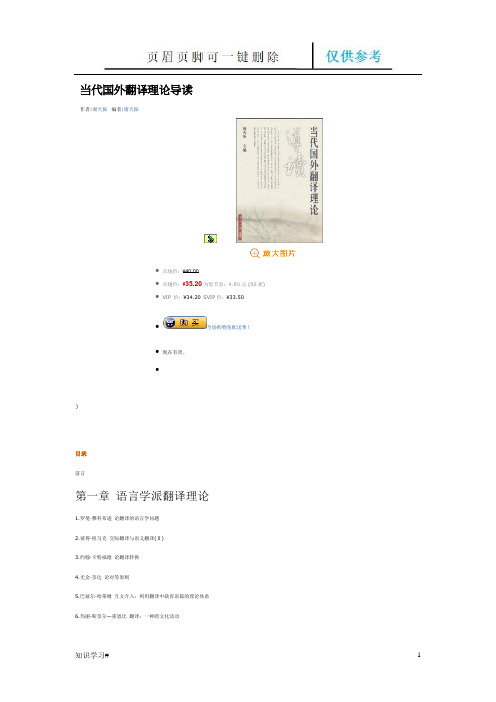
当代国外翻译理论导读作者:谢天振编者:谢天振•市场价:¥40.00•卓越价:¥35.20为您节省:4.80元 (88折)•VIP 价:¥34.20SVIP价:¥33.50•全场购物免配送费!•现在有货。
•)目录前言第一章语言学派翻译理论1.罗曼·雅科布逊论翻译的语言学问题2.彼得·纽马克交际翻译与语义翻译(Ⅱ)3.约翰·卡特福德论翻译转换4.尤金·奈达论对等原则5.巴兹尔·哈蒂姆互文介入:利用翻译中缺省语篇的理论体系6.玛丽·斯奈尔—霍恩比翻译:一种跨文化活动第二章阐释学派翻译理论7.乔治·斯坦纳阐释的步骤8.安托瓦纳·贝尔曼翻译及对异的考验第三章功能学派翻译理论9.凯瑟琳娜·莱斯翻译的抉择:类型、体裁及文本的个性10.汉斯·弗米尔翻译行为中的目的与委任11.克里斯汀娜·诺德目的、忠诚及翻译中的惯例第四章文化学派翻译理论12.詹姆斯·霍尔姆斯翻译学的名与实13.伊塔玛·埃文—佐哈翻译文学在文学多元系统中的地位14.吉迪恩·图里描述性翻译研究的理论基础15.安德烈·勒菲弗尔大胆妈妈的黄瓜:文学理论中的文本、系统和折射16.苏珊·巴斯奈特文化研究的翻译转向17.西奥·赫曼斯翻译研究及其新范式第五章解构学派翻译理论18.瓦尔特·本雅明译者的任务19.雅克·德里达巴别塔之旅20.保罗·德曼评本雅明的《译者的任务》21.劳伦斯·韦努蒂文化身份的塑造第六章女性主义翻译理论22.雪莉·西蒙翻译理论中的性别化立场23.劳丽·钱伯伦性别与翻译的隐喻24.巴巴拉·格达德女性主义话语/翻译的理论化25.冯·弗罗托女性主义翻译理论批评第七章后殖民翻译理论26.道格拉斯·罗宾逊后殖民研究与翻译研究27.特佳斯维妮·尼南贾纳翻译的定位28.盖亚特里·斯皮瓦克翻译的政治29.埃尔斯·维埃拉解放卡利班们——论食人说与哈罗德·德·坎波斯的超越/越界性创造诗学第八章苏东学派翻译理论30.安德烈·费奥多罗夫翻译理论的任务31.吉维·加切奇拉泽文学翻译中的创造性原则32.吉里·列维翻译是一个作选择的过程33.安娜·丽洛娃翻译研究的范畴Translation Theory(2007-09-29 14:13:41)标签:学习公社translationenglishtheoryTranslation TheoryBy Juan Daniel Pérez VallejoTranslation teacher,University of Cd. Del Carmen, Campeche, MexicoThe study of proper principle of translation is termed as translation theory. This theory, based on a solid foundation on understanding of how languages work, translation theory recognizes that different languages encode meaning in differing forms, yet guides translators to find appropriate ways of preserving meaning, while using the most appropriate forms of each language. Translation theory includes principles fortranslating figurative language, dealing with lexical mismatches, rhetorical questions, inclusion of cohesion markers, and many other topics crucial to good translation. Basically there are two competing theories of translation. In one,the predominant purpose is to express as exactly as possible the full force and meaning of every word and turn of phrase in the original, and in the other the predominant purpose is to produce a result that does not read like a translation at all, but rather moves in its new dress with the same ease as in its native rendering. In the hands of a good translator neither of these two approaches can ever be entirely ignored. Conventionally, it is suggested that in order to perform their job successfully, translators should meet three important requirements; they should be familiar with: the source languagethe target languagethe subject matterBased on this premise, the translator discovers the meaning behind the forms in the source language and does his best to produce the same meaning in the target language - using the forms and structures of the target language. Consequently, what is supposed to change is the form and the code and what should remain unchanged is the meaning and the message. (Larson, 1984)One of the earliest attempts to establish a set of major rules or principles to be referred to in literary translation was made by F rench translator and humanist Étienne Dolet, who in 1540 formulated the following fundamental principles of translation ("La Manière de Bien Traduire d’une Langue en Aultre"), usually regarded as providing rules of thumb for the practicing translator:The translator should understand perfectly the content and intention of the author whom he is translating. The principal way to reach it is reading all the sentences or the text completely so that you can give the idea that you want to say in the target language because the most important characteristic of this technique is translating the message as clearly and natural as possible. If the translation is for different countries besidesMexico, the translator should use the cultural words of that country. For example if he/she has to translate ”She is unloyal with her husband” in this country it can be translated as “Ella le pone los cuernos” but in Peru it can be translated as “Ella le pone los cachos”. In this case it is really important the cultural words beca use if the translator does not use them correctly the translation will be misunderstood. The translator should have a perfect knowledge of the language from which he is translating and an equally excellent knowledge of the language into which he is translating. At this point the translator must have a wide knowledge in both languages for getting the equivalence in the target language, because the deficiency of the knowledge of both languages will result in a translation without logic and sense. For example if you translate the following sentence “Are you interested in sports?” as “¿Estás interesado en deportes?” the translation is wrong since the idea of this question in English is “¿Practicas algún deporte?”The translator should avoid the tendency to translate word by word, because doing so is to destroy the meaning of the original and to ruin the beauty of the expression_r. This point is very important and one of which if it is translated literally it can transmit another meaning or understanding in the translation.For example in the sentence.- “In this war we have to do or die”, if we translate literally “En esta guerra tenemos que hacer o morir” the message is unclear. The idea is, (.) “En esta guerra tenemos que vencer o morir.”The translator should employ the forms of speech in common usage. The translator should bear in mind the people to whom the translation will be addressed and use words that can be easily understood.Example. “They use a sling to lift the pipes” if the translation is to be read by specialists we would translate it “Utilizan una eslinga para levantar la tubería”. If the text is to be read by people who are not specialists we would rather translate it “Utilizan una cadena de suspension para levantar los tubos”.。
第四章 当代西方翻译理论
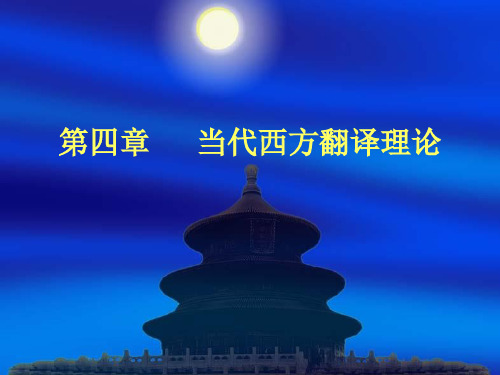
威密尔则突破了对等理论的限制 ,以文本目的(skopos)为翻译过程的第 一准则 ,发展了功能派的主要理论:目的论(skopos theory) 。威密尔所提 出的目的论(skopos theory)是功能派翻译理论中最重要的理论。skopos 是希腊词 ,意思是 “目的” 。根据目的论 ,所有翻译遵循的首要法则 就是 “目的法则” :翻译行为所要达到的目的决定整个翻译行为的过 程 ,即结果决定方法。这个目的有三种解释:译者的目的;译文的交际 目的;和使用某种特殊翻译手段所要达到的目的。通常情况下 , “目的” 是指译文的交际目的。
德国功能主义流派
二十世纪七十年代 ,德国出现一派翻译理论 — —功能派翻
译理论。功能派认为翻译(包括口、 笔译)是一种行为。其 理论的重点表现在三方面: (1)对翻译实质的阐释(2)对翻译 过程参与者的角色分析(3)功能翻译原则的提出。
谈到功能派,就不得不提及三位功能派翻译理论杰出的贡献
20世纪20年代起,前苏联的文学翻译得到发展的同时,翻
译研究也得到长足的进展。其最大特点就是一开始就和文 学翻译紧密联系在一起,但这时还是注重翻译作品的艺术 性。文艺学派开始于当时的俄国形式主义,代表人物为蒂 尼亚诺夫。
楚柯夫斯基的《崇高的艺术》一书问世后,被视为前苏联
译坛文艺学派的代表作之一,此书立足于大量丰富的翻译 实践,探讨了使翻译作品成为真正的艺术作品的途径。
纽马克在《翻译问题探讨》出版,立刻引起广泛赞誉。正
是在这本书中,他提出了“语义翻译”和交际翻译的概念。 此后,分别于1993年何1995年,又出版了《翻译短评》 (Paragraphs on Translation)和《翻译短评(第二集)》 (More paragraphs on Translation)。 翻译试图在译人语的语义和句法结构允许的范围内传达原 著的确切上下文意义。交际翻译试图对译文读者产生一种 效果 ,这效果要尽可能接近原文对读者所产生的效果。 语义翻译的服务对象是原语作者,交际翻译服务的对象是 译入语的读者 。这两种方法的一个根本区别在于:当出现 矛盾时,交际翻译必须强调“ 表现力” ,而不强调信息 的内容。
毕业论文英文翻译文献

毕业论文英文翻译文献随着全球化的发展,英语在全球的运用越来越广泛。
下文是店铺为大家整理的关于毕业论文英文翻译文献的内容,欢迎大家阅读参考! 毕业论文英文翻译文献(一)1. 谢天振主编. 《当代国外翻译理论导读》. 天津:南开大学出版社,2008.2. 包惠南、包昂. 《中国文化与汉英翻译》. 北京:外文出版社, 2004.3. 包惠南. 《文化语境与语言翻译》. 北京:中国对外翻译出版公司. 2001.4. 毕继万. 《世界文化史故事大系——英国卷》. 上海:上海外语教育出版社, 2003.5. 蔡基刚. 《英汉汉英段落翻译与实践》. 上海:复旦大学出版社, 2001.6. 蔡基刚. 《英汉写作对比研究》. 上海:复旦大学出版社, 2001.7. 蔡基刚. 《英语写作与抽象名词表达》. 上海:复旦大学出版社, 2003.8. 曹雪芹、高鄂. 《红楼梦》.9. 陈定安. 《英汉比较与翻译》. 北京:中国对外翻译出版公司, 1991.10. 陈福康. 《中国译学理论史稿》(修订本). 上海:上海外语教育出版社. 2000.11. 陈生保. 《英汉翻译津指》. 北京:中国对外翻译出版公司. 1998.12. 陈廷祐. 《英文汉译技巧》. 北京:外语教学与研究出版社. 2001.13. 陈望道. 《修辞学发凡》. 上海:上海教育出版社, 1979.14. 陈文伯. 《英汉翻译技法与练习》. 北京:世界知识出版社. 1998.15. 陈中绳、吴娟. 《英汉新词新义佳译》. 上海:上海翻译出版公司. 1990.16. 陈忠诚. 《词语翻译丛谈》. 北京:中国对外翻译出版公司, 1983.17. 程希岚. 《修辞学新编》. 吉林:吉林人民出版社, 1984.18. 程镇球. 《翻译论文集》. 北京:外语教学与研究出版社. 2002.19. 程镇球. 《翻译问题探索》. 北京:商务印书馆, 1980.20. 崔刚. 《广告英语》. 北京:北京理工大学出版社, 1993.21. 单其昌. 《汉英翻译技巧》. 北京:外语教学与研究出版社. 1990.22. 单其昌. 《汉英翻译讲评》. 北京:对外贸易教育出版社. 1989.23. 邓炎昌、刘润清. 《语言与文化——英汉语言文化对比》. 北京:外语教学与研究出版社, 1989.24. 丁树德. 《英汉汉英翻译教学综合指导》. 天津:天津大学出版社, 1996.25. 杜承南等,《中国当代翻译百论》. 重庆:重庆大学出版社, 1994.26. 《翻译通讯》编辑部. 《翻译研究论文集(1894-1948)》. 北京:外语教学与研究出版社. 1984.27. 《翻译通讯》编辑部. 《翻译研究论文集(1949-1983)》. 北京:外语教学与研究出版社. 1984. .28. 范勇主编. 《新编汉英翻译教程》. 天津:南开大学出版社. 2006.29. 方梦之、马秉义(编选). 《汉译英实践与技巧》. 北京:旅游教育出版社. 1996.30. 方梦之. 《英语汉译实践与技巧》. 天津:天津科技翻译出版公司. 1994.31. 方梦之主编. 《译学辞典》. 上海:上海外语教育出版社. 2004.32. 冯翠华. 《英语修辞大全》,北京:外语教学与研究出版社, 1995.33. 冯庆华. 《文体与翻译》. 上海:上海外语教育出版社, 2002.34. 冯庆华主编. 《文体翻译论》. 上海:上海外语教育出版社. 2002.35. 冯胜利. 《汉语的韵律、词法与句法》. 北京:北京大学出版社, 1997.36. 冯志杰. 《汉英科技翻译指要》. 北京:中国对外翻译出版公司. 1998.37. 耿占春. 《隐喻》. 北京:东方出版社, 1993.38. 郭建中. 《当代美国翻译理论》. 武汉:湖北教育出版社. 2000.39. 郭建中. 《文化与翻译》. 北京:中国对外翻译出版公司. 2000.40. 何炳威. 《容易误译的英语》. 北京:外语教学与研究出版社. 2002.41. 何刚强. 《现代英汉翻译操作》. 北京:北京大学出版社. 1998.42. 何刚强. 《现代英语表达与汉语对应》. 上海:复旦大学出版社. 1994.43. 何刚强. 《英汉口笔译技艺》. 上海:复旦大学出版社, 2003. 毕业论文英文翻译文献(二)1. 何自然、张达三、杨伟钧等译. 《现代英语语法教程》. 北京:商务印书馆, 1990.2. 何自然. 《语用学概论》. 长沙: 湖南教育出版社, 1988.3. 侯维瑞. 《英语语体》. 上海:上海外语教育出版社, 1988.4. 胡庚申. 《怎样起草与翻译合同协议》. 合肥:中国科技大学出版社, 1993.5. 胡曙中. 《英汉修辞比较研究》. 上海:上海外语教育出版社, 1993.6. 胡晓吉. 《实用英汉对比翻译》. 北京:中国人民大学出版社. 1990.7. 胡燕平,张容建. 《实用英汉翻译类典》. 重庆:重庆出版社, 1997.8. 胡裕树. 《现代汉语》. 上海:上海教育出版社, 1987.9. 胡兆云. 《美学理论视野中的文学翻译研究》(第2版). 北京:现代教育出版社. 2009.10. 胡兆云. 《语言接触与英汉借词研究》. 济南:山东大学出版社. 2001.11. 胡壮麟. 《语篇的衔接与连贯》. 上海:上海外语教育出版社, 1994.12. 胡壮麟. 《语言学教程》. 北京:北京大学出版社, 1988.13. 黄伯荣, 廖序东. 《现代汉语》. 兰州:甘肃人民出版社, 1981.14. 黄国文. 《语篇分析概要》. 长沙:湖南教育出版社, 1988.15. 黄龙. 《翻译技巧指导》. 沈阳:辽宁人民出版社, 1986.16. 黄任. 《英语修辞与写作》. 上海:上海外语教育出版社, 1996.17. 黄雨石. 《英汉文学翻译探索》. 西安:陕西人民出版社. 1988.18. 黄振定. 《翻译学:艺术论与科学论的统一》. 长沙:湖南教育出版社. 1998.19. 黄振定. 《翻译学的语言哲学基础》. 上海:上海交通大学出版社. 2007.20. 黄忠廉. 《变译理论》. 北京:中国对外翻译出版公司. 2002.21. 贾尔斯英译. 《孙子兵法》. 长沙:湖南出版社, 1993.22. 贾文波. 《汉英时文翻译: 政治经济汉译英300句析》. 北京:中国对外翻译出版公司, 1999.23. 贾玉新. 《跨文化交际学》. 上海:上海外语教育出版社, 1997.24. 金隄. 《等效翻译探索》. 北京:中国对外翻译出版公司. 1998.25. 金惠康. 《汉英跨文化交际翻译》. 贵阳:贵州教育出版社. 1998.26. 金惠康. 《跨文华交际翻译》. 北京:中国对外翻译出版公司, 2003.27. 金惠康. 《跨文华交际翻译续编》. 北京:中国对外翻译出版公司, 2004.28. 金立鑫. 《语法的多视角研究》. 上海:上海外语教育出版社, 2000.29. 居祖纯. 《新编汉英语篇翻译》. 北京:清华大学出版社, 2002.30. 柯平. 《对比语言学》. 南京:南京师范大学出版社, 1999.31. 孔慧怡. 《翻译·文学·文化》. 北京:北京大学出版社. 1999.32. 李定坤. 《汉英辞格对比与翻译》. 武汉:华中师范大学出版社, 1994.33. 李国南. 《辞格与词汇》. 上海:上海外语教育出版社, 2002.34. 李国南. 《英汉修辞格对比研究》. 福州:福建人民出版社, 1999.35. 李明编著. 《英汉互动翻译教程》. 武汉:武汉大学出版社. 2006.36. 李瑞华(主编). 《英汉语言文化对比研究》. 上海:上海外语教育出版社. 1996.。
当代西方翻译理论探索.doc

当代西方翻译理论探索西方翻译史,按照谭载喜在《西方翻译简史》中的划分,可分为古代翻译、中世纪翻译、文艺复兴时期的翻译、近代翻译和现代翻译。
而翻译理论的发展,也可遵循这一分期。
一、古代时期西方翻译理论发韧于公元前1世纪,以古罗马帝国政治家和演说家西塞罗(Cicero,前l06—43)发表的《论演说术》为标志。
他在这篇演说中声言:“我认为,在翻译时,逐字翻译是不必要的,我所做的是保留原文的整体风格及其语言的力量。
因为,我相信,像数硬币一样地向读者一个个地数词,不是我的责任,我的责任是按照他们的实际重量支付给读者。
”这段话首次对直译和意译进行了区分,并明确提出反对逐字翻译。
他所关心的问题是如何正确地翻译希腊文学典籍以及基督教《圣经》,所采用的研究方法是语文学的,主要注重原文的文学特征,热衷于讨论译者是该直译还是意译的问题。
二、中世纪时期这一时期从西罗马帝国崩溃起(476年)至15世纪文艺复兴止。
主要的代表人物有罗马神学家、政治家、哲学家和翻译家曼里乌·波伊提乌(ManliusBoetNus,480?-524?)。
他提出宁要内容准确,不要风格优雅的直译主张和译者应当放弃主观判断权的客观主义观点。
但是,纵观整个中世纪,西方翻译理论研究仍然末成系统。
在波伊提乌之后,翻译理论研究在较长时间里几乎处于停顿状态。
三、文艺复兴时期文艺复兴时期从14世纪末起至l7世纪初止。
这一时期是西方各国翻译实践和理论研究的飞跃期。
翻译理论的主要代表人物有德国的德西德利乌。
伊拉斯摸(DesNerjusErasmus,1466?一1536)和马丁·路德(MartinLuther,1483一l546);法国的雅克·阿米欧(JacuesAmyot,1513—1593)和艾蒂安·多雷(EtienneDolet,1509一1546);英国的乔治·查普曼(GeorgeChapman)。
伊拉斯摸认为:(一)翻译必须尊重原作;(二)翻译者必须具有丰富的语文知识;(三)风格是翻译的重要组成部分。
当代美国翻译理论
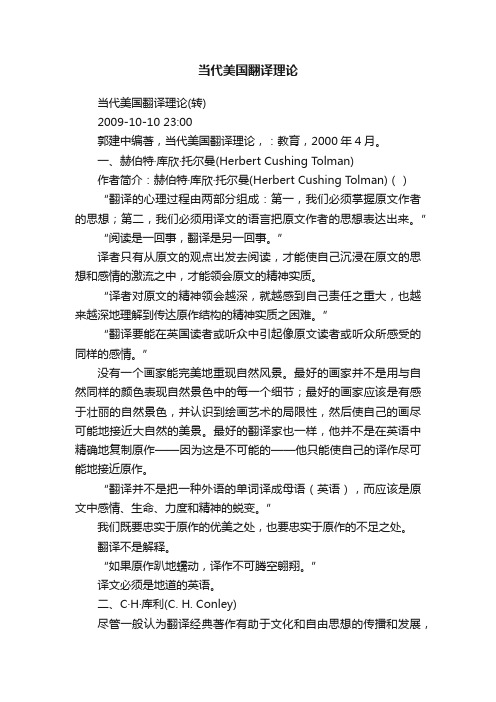
当代美国翻译理论当代美国翻译理论(转)2009-10-10 23:00郭建中编著,当代美国翻译理论,:教育,2000年4月。
一、赫伯特·库欣·托尔曼(Herbert Cushing Tolman)作者简介:赫伯特·库欣·托尔曼(Herbert Cushing Tolman)()“翻译的心理过程由两部分组成:第一,我们必须掌握原文作者的思想;第二,我们必须用译文的语言把原文作者的思想表达出来。
”“阅读是一回事,翻译是另一回事。
”译者只有从原文的观点出发去阅读,才能使自己沉浸在原文的思想和感情的激流之中,才能领会原文的精神实质。
“译者对原文的精神领会越深,就越感到自己责任之重大,也越来越深地理解到传达原作结构的精神实质之困难。
”“翻译要能在英国读者或听众中引起像原文读者或听众所感受的同样的感情。
”没有一个画家能完美地重现自然风景。
最好的画家并不是用与自然同样的颜色表现自然景色中的每一个细节;最好的画家应该是有感于壮丽的自然景色,并认识到绘画艺术的局限性,然后使自己的画尽可能地接近大自然的美景。
最好的翻译家也一样,他并不是在英语中精确地复制原作——因为这是不可能的——他只能使自己的译作尽可能地接近原作。
“翻译并不是把一种外语的单词译成母语(英语),而应该是原文中感情、生命、力度和精神的蜕变。
”我们既要忠实于原作的优美之处,也要忠实于原作的不足之处。
翻译不是解释。
“如果原作趴地蠕动,译作不可腾空翱翔。
”译文必须是地道的英语。
二、C·H·库利(C. H. Conley)尽管一般认为翻译经典著作有助于文化和自由思想的传播和发展,但16世纪英国经典著作的翻译反而助长了反动的社会和文化专制主义。
三、亨利·伯罗特·莱思罗普(Henry Burrowes Lathrop)16世纪英国所翻译的希腊罗马经典著作和我们今天所熟悉的完全不一样。
当代西方翻译理论(一)
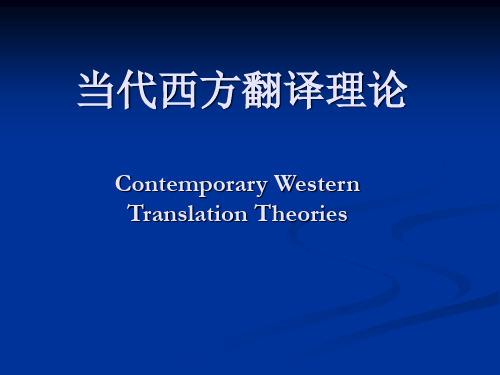
Functionalist approaches to translation
Hans J. Vermeer Skopos theory Christiane Nord Functionality plus loyalty
Descriptive approaches to translation
George Steiner Hermeneutic approaches to translation Jacques Derrida Deconstructionist translation theory
Cognitive approaches to translat Cognitive approaches to translation
Studies serve for delight, for ornament, and for ability. 王佐良译文: 读书足以怡情,足以傅采,足以长才。 曹明伦译文: 读书之用有三:一位怡神旷心,二为增趣添雅, 三为长才益智。 廖运范译文: 读书能给人乐趣、文雅和能力。
人法地,地法天,天法道,道法自然
Empirical research in translation studies
Wolfgang Lǒrscher Think-aloud as a method Mona Baker Corpus-based translation studies
Linguistic approaches to translation
For a good harvest both in sports and morals
White elephant ——good-for nothing 白象?!
当代西方翻译理论

当代西方翻译研究的三大突破,两大转向三大突破1)20世纪50年代以来的西方翻译研究开始从一般层面上的对两种语言转换的技术问题的研究,也即从“怎么译”的问题,深入到了对翻译行为本身的深层探究。
提出了语音、语法、语义等一系列的等值问题。
当代西方翻译研究中的等值论等研究,虽然有它的局限,但它对翻译所作的微观分析,无疑使人们对翻译的过程和目标,看得更加清楚了,更加透彻了。
2)当代西方的翻译研究不再局限于翻译文本本身的研究,而把目光投射到了译作的发起者、翻译文本的操作者和接受者身上。
它借鉴了接受美学、读者反应等理论,跳出了对译文与原文之间一般字面上的忠实与否之类问题的考察,而注意到了译作在新的文化语境里的传播与接受,注意到了翻译作为一种跨文化的传递行为的最终目的和效果,还注意到了译者在这整个的翻译过程中所起的作用。
3)当代翻译研究的最大突破还表现在把翻译放到一个宏大的文化语境中去审视。
研究者开始关注翻译研究中语言学科以外的其他学科的因素。
他们一方面认识到翻译研究作为一门独立学科的性质,另一方面又看到了翻译研究这门学科的多学科形式,注意到它不仅与语言学,而且还与文艺学、哲学甚至社会学、心理学等学科都有密不可分的关系。
但是翻译研究最终关注的当然还是文本在跨文化交际和传递中所涉及的一系列文化问题,诸如文化误读、信息增添、信息失落等。
两大转向1)语言学派的转向2)从文化层面来审视翻译的转向当代西方翻译理论语言学派理论从20世纪50年代起,西方出现了一批运用现代语言学的结构理论、转换生成理论、功能理论、话语理论、信息论等理论的学者,他们把翻译问题纳入到语言学的研究领域,从比较语言学、应用语言学、社会语言学、语义学、符号学、交际学等角度,提出了相对严谨的翻译理论和方法,开拓出了翻译研究的新领域,给传统的翻译研究注入了新的内容。
他们是当代西方翻译史上名副其实的翻译理论家,其中最主要的代表人物有:雅可布逊(Roman Jakobson)尤金·奈达(Eugen A. Nida)卡特福特(J.C. Catford)彼得·纽马克(Peter Newmark)从严格意义上而言,是这批学者对翻译问题的学术探讨,揭开了当代西方翻译史上的理论层面。
当代国外翻译理论
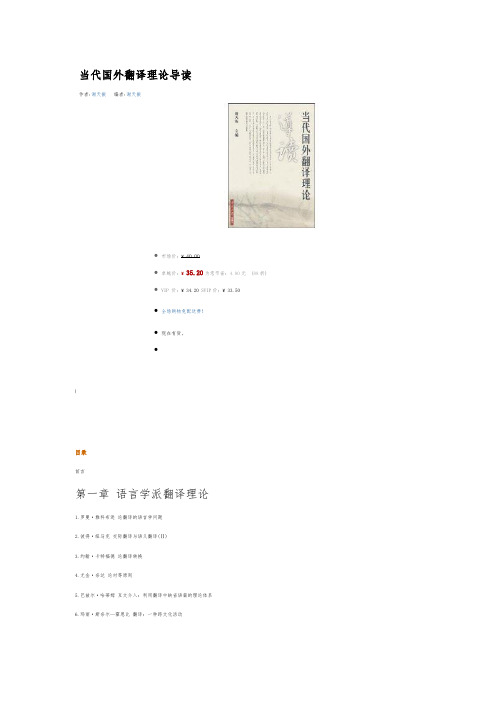
当代国外翻译理论导读作者:谢天振编者:谢天振•市场价:¥40.00•卓越价:¥35.20为您节省:4.80元(88折)•VIP 价:¥34.20 SVIP价:¥33.50•全场购物免配送费!•现在有货。
•)目录前言第一章语言学派翻译理论1.罗曼·雅科布逊论翻译的语言学问题2.彼得·纽马克交际翻译与语义翻译(Ⅱ)3.约翰·卡特福德论翻译转换4.尤金·奈达论对等原则5.巴兹尔·哈蒂姆互文介入:利用翻译中缺省语篇的理论体系6.玛丽·斯奈尔—霍恩比翻译:一种跨文化活动第二章阐释学派翻译理论7.乔治·斯坦纳阐释的步骤8.安托瓦纳·贝尔曼翻译及对异的考验第三章功能学派翻译理论9.凯瑟琳娜·莱斯翻译的抉择:类型、体裁及文本的个性10.汉斯·弗米尔翻译行为中的目的与委任11.克里斯汀娜·诺德目的、忠诚及翻译中的惯例第四章文化学派翻译理论12.詹姆斯·霍尔姆斯翻译学的名与实13.伊塔玛·埃文—佐哈翻译文学在文学多元系统中的地位14.吉迪恩·图里描述性翻译研究的理论基础15.安德烈·勒菲弗尔大胆妈妈的黄瓜:文学理论中的文本、系统和折射16.苏珊·巴斯奈特文化研究的翻译转向17.西奥·赫曼斯翻译研究及其新范式第五章解构学派翻译理论18.瓦尔特·本雅明译者的任务19.雅克·德里达巴别塔之旅20.保罗·德曼评本雅明的《译者的任务》21.劳伦斯·韦努蒂文化身份的塑造第六章女性主义翻译理论22.雪莉·西蒙翻译理论中的性别化立场23.劳丽·钱伯伦性别与翻译的隐喻24.巴巴拉·格达德女性主义话语/翻译的理论化25.冯·弗罗托女性主义翻译理论批评第七章后殖民翻译理论26.道格拉斯·罗宾逊后殖民研究与翻译研究27.特佳斯维妮·尼南贾纳翻译的定位28.盖亚特里·斯皮瓦克翻译的政治29.埃尔斯·维埃拉解放卡利班们——论食人说与哈罗德·德·坎波斯的超越/越界性创造诗学第八章苏东学派翻译理论30.安德烈·费奥多罗夫翻译理论的任务31.吉维·加切奇拉泽文学翻译中的创造性原则32.吉里·列维翻译是一个作选择的过程33.安娜·丽洛娃翻译研究的范畴Translation Theory(2007-09-29 14:13:41)标签:学习公社translationenglishtheoryTranslation TheoryBy Juan Daniel Pérez VallejoTranslation teacher,University of Cd. Del Carmen, Campeche, MexicoThe study of proper principle of translation is termed as translation theory. This theory, based on a solid foundation on understanding of how languages work, translation theory recognizes that different languages encode meaning in differing forms, yet guides translators to find appropriate ways of preserving meaning, while using the most appropriate forms of each language. Translation theory includes principles for translating figurative language, dealing with lexical mismatches, rhetorical questions, inclusion of cohesion markers, and many other topics crucial to good translation. Basically there are two competing theories of translation. In one,the predominant purpose is to express as exactly as possible the full force and meaning of everyword and turn of phrase in the original, and in the other the predominant purpose is to produce a result that does not read like a translation at all, but rather moves in its new dress with the same ease as in its native rendering. In the hands of a good translator neither of these two approaches can ever be entirely ignored. Conventionally, it is suggested that in order to perform their job successfully, translators should meet three important requirements; they should be familiar with: the source languagethe target languagethe subject matterBased on this premise, the translator discovers the meaning behind the forms in the source language and does his best to produce the same meaning in the target language - using the forms and structures of the target language. Consequently, what is supposed to change is the form and the code and what should remain unchanged is the meaning and the message. (Larson, 1984)One of the earliest attempts to establish a set of major rules or principles to be referred to in literary translation was made by French translator and humanist Étienne Dolet, who in 1540 f ormulated the following fundamental principles of translation ("La Manière de Bien Traduire d’une Langue en Aultre"), usually regarded as providing rules of thumb for the practicing translator:The translator should understand perfectly the content and intention of the author whom he is translating. The principal way to reach it is reading all the sentences or the text completely so that you can give the idea that you want to say in the target language because the most important characteristic of this technique is translating the message as clearly and natural as possible. If the translation is for different countries besides Mexico, the translator should use the cultural words of that country. For example if he/she has to translate ”She is unloyal with her husband” in this country it can be translated as “Ella le pone los cuernos” but in Peru it can be translated as “Ella le pone los cachos”. In this case it is really important the cultural words because if the translator does not use them correctly the translation will be misunderstood.The translator should have a perfect knowledge of the language from which he is translating and an equally excellent knowledge of the language into which he is translating. At this point the translator must have a wide knowledge in both languages for getting the equivalence in the target language, because the deficiency of the knowledge of both languages will result in a translation without logic and sense. For example if you translate the following sentence “Are you interested in sports?” as “¿Estás interesado en deportes?” the translation is wrong since the idea of this question in English is “¿Practicas algún deporte?”The translator should avoid the tendency to translate word by word, because doing so is to destroy the meaning of the original and to ruin the beauty of the expression_r. This point is very important and one of which if it is translated literally it can transmit another meaning or understanding in the translation.For example in the sentence.- “In this war we have to do or die”, if we translate literally “En esta guerra tenemos que hacer o morir” the message is unclear. The idea is, (.) “En esta guerra tenemos que vencer o morir.”The translator should employ the forms of speech in common usage. The translator should bear in mind the people to whom the translation will be addressed and use words that can be easily understood.Example. “They use a sling to lift the pipes” if the translation is to be read by specialists we would translate it “Utilizan una esling a para levantar la tubería”. If the text is to be read by people who are not specialists we would rather translate it “Utilizan una cadena de suspension para levantar los tubos”.Flip to Text Version La Trobe UniversityHarry AvelingA Short History of Western Translation Theory1. Traditional Translation TheoriesThere is a continuity of intellectual expression from Ancient Greece, Rome, the Middle Ages, through to the Renaissance, the Reformation, and the rise of the early European nation states. The central language of scholars and other readers was Latin, while the core of this tradition was classicalliterature and Judeo-Christianity. There was a profusion of economic and political contacts throughout Europe and the Middle East, and this must have involved an abundance of linguistic transactions. Nevertheless, Lefevere"s words provide an accurate background to understanding the social position of the subjects of traditional translation theory: "In such a culture, translations were not primarily read for information or the mediation of the foreign text. They were produced and read as exercises, first pedagogical exercises, and later on, as exercises in cultural appropriation - in the conscious and controlled usurpation of authority." (Lefevere 1990: 16).2. German RomanticismAt the beginning of the nineteenth century, a second, more philosophical and less empirical, formation began to open within discourses on translation theory (Munday 2001: 27). This formation was connected, in one direction, with the rise of philology as a university discipline, and in another with the literary movement of Romanticism. Philology provided a range of new and exotic texts and allowed the experts to produce translations aimed primarily at other experts, not the general culture of which these scholars were a part (Lefevere 1990: 22). Romanticism exalted the translator "as a creative genius in his own right, in touch with the genius of his original and enriching the literature and language into which he is translating" (Bassnett-McGuire 1980: 65). The stress on both the original author and the translator as being artists was not part of traditional discourse formations.3. The Early and Middle Twentieth CenturyDiscussion in English of translation theory during the first half of the twentieth century continued to be dominated by the themes of Victorian discourse on translation, "literalness, archaizing, pedantry and the production of a text of second-rate literary merit for an elite minority" (Bassnett-McGuire 1980: 73). In his list of major contributors to the area of translation theory, Steiner recognises only the names of Dryden, Quine and Pound among English-speakers. Quine and Pound both belong to the twentieth century and challenged the dominant discourse. Willard V. Quine (b. 1908), a major American philosopher, wrote on "the indeterminacy of translation" within the field of linguistic philosophy (Quine 1960). Ezra Pound (1885-1972) was a poet and critic. Ronnie Apter has argued that Pound made three major innovations to thinking about "the nature and intent of literary translation…he discarded the Victorian pseudo-archaic translation diction; he regarded each translation as a necessarily limited criticism of the original poem; and he regarded good translations as new poems in their own right" (Apter 1987: 3).More radical, and more decisive, developments in translation theory took place in Europe. These begin with the Russian Formalist movement, whichfocused on the "what makes literary texts different from other texts, what makes them new, creative, innovative" (Gentzler 1993: 79). One of their answers was that literary texts rely on a process of "defamiliarisation", using language in new and strikingly different ways from ordinary speech. This led the Formalist to focus on "surface structural features" and "to analyse them to learn what determines literary status" (Gentzler 1993: 79). In so doing, they began the search for descriptive rules, which would help scholars understand the process of translation, and not normative rules, in order to study and assess the work of other translators (Bell 1991: 12). Their work was extended and refined by the Prague school of linguistics, founded by Roman Jakobson, who had earlier worked in Moscow. In his essay "On the Linguistic Aspects of Translation" (1959), Jakobson expanded traditional discourse of "equivalence" into the theme of "equivalence in difference". In so doing, he argued that words should be seen within their (arbitrary) semiotic context, and that "the grammatical pattern of a language (as opposed to its lexical stock) determines those aspects of each experience that must be expressed in the given language" (Venuti 2000: 114).4. Translation StudiesThree factors worked to limit this sharp focus on descriptive linguistics as the major form of discourse on translation. The first was the questioning of Chomsky"s linguistic theories by linguists themselves. The second was the development of a number of new and dynamic fields within linguistics, such as "discourse analysis, text linguistics, sociolinguistics, computational linguistics, prototype semantics, and other assorted wonders" (Pym 1992: 184). These "wonders" took in prior fields such as British social anthropology and American cultural anthropology, as well as contemporary and parallel developments in philosophy, information and communication theories, computational linguistics, machine translation, artificial intelligence, and the ideas of socio-semiotics as developed within French structuralist and post-structuralist thought (Nida 2001: 110). The sense increased that: "Language is not the problem. Ideology and politics are…" (Lefevere 1990: 26). This has led to a separation between linguistic and cultural approaches to translation in the last quarter of the twentieth century. For some translation scholars, indeed, it has seemed that "strictly linguistic theories have been superseded, [as] translation has come to be considered in its cultural, historical and sociological context" (Woodsworth 1998: 100).Basic Knowledge of Translation TheoryI.Translation1.Definition1)The definition in the old daysl“译即易,谓换易言语使相解也。
当代翻译理论
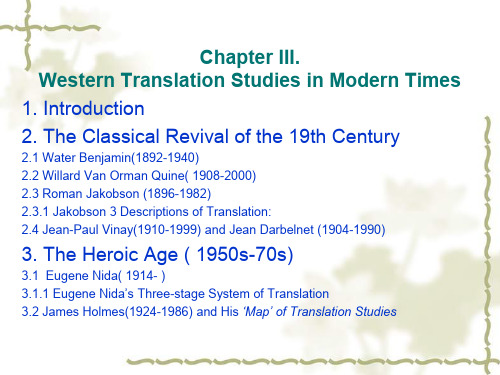
1. Introduction
As translation historian claim, the classical revival of the 19th century and the emphasis on technical accuracy, combined with a spirit of exclusivism among the intelligentsia, conspired to make the 19th century pedantic in its attitude towards translation. The 20th century witnessed a radical change in Western translation studies. In fact, 5 developments have had a significant effect on the theory and practice of translation during the 20th century:
Jakobson follows the relation set out by Saussure between the signifier and the signified. From a linguistic and semiotic angle, he approaches the problem of equivalence with the following, now famous, definition: equivalence in difference is the cardinal problem of language and the critical concern of linguistics. For him, the problem of meaning and equivalence focuses on differences in the structure and terminology of languages rather than on any inability of one language to render a message that has been written in another verbal language.
当代西方主要翻译流派及其理论家

《当代国外翻译理论导读》主要翻译流派及学者语言学派翻译理论Roman Jakobson 罗曼·雅科布逊原籍俄罗斯,后移居捷克,最后加入美国国籍Bertrand Russell 柏特兰·罗素Peter Newmark 彼得·纽马克J. C. Catford 约翰·卡特福特,英国Eugene Nida尤金·奈达,美国Basil Hatim巴兹尔·哈蒂姆Mary Snell-Hornby玛丽·斯奈尔—霍恩比阐释学派翻译理论George Steiner乔治·斯坦纳,英国Antoine Berman安托瓦纳·贝尔曼,法国功能学派翻译理论Katharina Reiss 凯瑟琳娜·莱斯,德国Hans Vermeer 汉斯·弗米尔,德国Christiane Nord 克里斯汀娜·诺德,德国文化学派翻译理论James Holmes 詹姆斯·霍尔姆斯Itamar Even-Zohar伊塔玛·埃文—佐哈,以色列Gideon Toury 吉迪恩·图里AndréLefevere安德烈·勒菲弗尔Susan Bassnett苏珊·巴斯奈特,英国Theo Hermans西奥·赫曼斯,荷兰解构学派翻译理论Walter Benjamin瓦尔特·本雅明,德国J. Jacques Derrida 雅克·德里达,法国Paul de Man保罗·德曼,美国Lawrence Venuti劳伦斯·韦努蒂,美籍意大利翻译理论家女性主义翻译理论Sherry Simon雪莉·西蒙,加拿大Lori Chamberlain劳丽·钱伯伦Barbara Godard 巴巴拉·格达德,加拿大Luise von Flotow 路易斯·冯·弗罗托后殖民主义翻译理论Douglas Robinson 道格拉斯·罗宾逊,美国Tejaswini Niranjana 特佳斯维妮·尼南贾纳,印度Gayatri Chakravorty Spivak 盖亚特里·斯皮瓦克,印度裔美学Else Ribeiro Pires Vieira埃尔斯·丽贝罗·皮尔斯·维埃拉,巴西苏东学派翻译理论安德烈·费道罗夫吉维·加切奇拉泽吉里·列维安娜·里洛娃。
上海外国语大学翻译学专业博士生必读书目

上海外国语大学翻译学专业博士研究生培养方案为了配合实施《中华人民共和国学位条例》,保证学位研究生的质量,特制定翻译学专业博士研究生培养方案。
一、培养目标:1、培养我国社会主义建设事业所需要的,具有马克思主义理论修养、坚持四项基本原则、德、智、体全面发展的人才。
2、翻译学博士生通过培养,应具备扎实的相关理论与专业知识,通晓翻译学学科研究的前沿理论和最新国内外研究成果,能从事翻译学科高层次理论研究和教学,勇于进行理论创新,具备独立的科研能力、遵守学术规范的翻译研究工作者。
二、研究方向及导师:三、颁发学位翻译学博士四、学习年限学制三年,视情况可根据申请延长一年或两年五、课程学习以及学分要求总学分:22学分其中:公共必修课2门课10学分;学位必修课3门课6学分学位选修课3门课6 学分六、课程设置学位课七、培养方式采用研讨课(第一学年)、实验和论文指导(第二、三学年)相结合的方式。
八、学位论文要求时间安排:第三学期与导师讨论后选定论文题目,撰写学位论文选题报告,并于期末在学院专业学术委员会组织召开的选题审定会上进行答辩,答辩通过后进入论文撰写。
第四、第五、第六学期撰写论文以及进行与论文相关的实验。
第六学期末进行论文答辩。
字数要求:论文长度中文为12万字左右,英文为5万词左右。
质量要求:论文必须在导师指导下由博士生本人独立完成。
论文内容与本专研究方向相关,代表本学科研究方向的前沿水平,研究成果具有理论和实践的创新意义。
论文应论点明确,结构严谨完整,反映作者的坚实理论基础、系统专业知识、科学研究方法,并有独立见解。
九、对科研能力和水平的要求博士研究生在学期间,应关注和充分了解所学专业的国际和国内的动态与前景,同时参与一些专题的讨论和研究,逐步获得高层次的独立研究能力。
在读期间,博士生在论文答辩前,须以第一作者至少在国内核心刊物上发表至少两篇学术论文,并积极参与导师主持的相关科研项目。
十、对社会实践方面的要求:博士生在条件容许的情况下,应积极参加各种国内外学术交流活动。
翻译理论导读之二:功能学派翻译理论
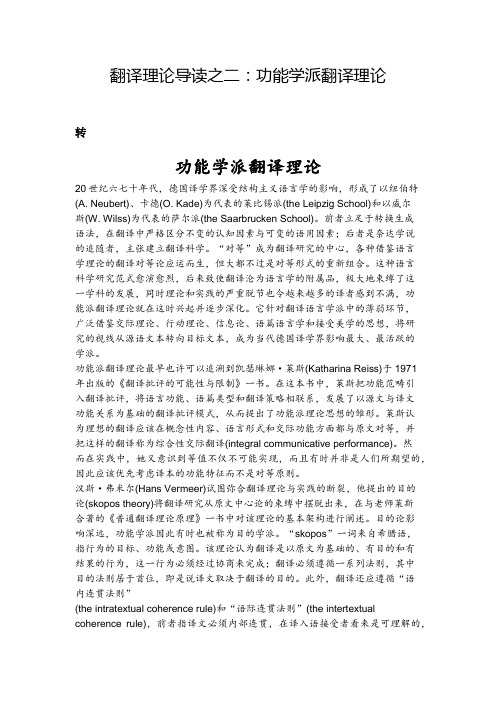
在此基础上,执教芬兰的德国学者贾斯塔·霍茨—曼塔里借鉴交际和行为理论,提出翻译行为论(theory of translational action),进一步发展了功能派翻译理论。她的学术观点集中体现在1984年发表的《翻译行为——理论与方法》一书中。这一理论将翻译视作受目的驱使的、以翻译结果为导向的人与人之间的相互作用,并对翻译过程中的行为及参与者的角色予以细致的分析,主要包括:发起人/客户(the initiator/client)、委托人(the commissioner)、原文作者(the ST producer)、译者(the TT producer)、译本使用者(the TT user)及译本接受者(the TT receiver),他们并非参与每一个翻译过程,有时一个人可以同时担任几个不同的角色。翻译行为论和目的论有颇多相通之处,弗米尔后来也将二者相融合。不过曼塔里的方法和概念模式显然比目的论更为激进,她把翻译看作包括文本、图片、声音、肢体语言等复合信息传递物(message-transmitter compounds)在不同文化之间的迁移,用“翻译行为”(translatorial action)来代替翻译(translation),将改编、编译、编辑和资料查询都包括在内,同时在理论中大量借鉴商业和管理学术语。
当代西方翻译理论

从发展趋势上看,语言学翻译理论线已占据现代翻译理论
研究中的主导地位。理论学家们认为,翻译应归属与语言 学的研究范围,是应用语言学和比较语言学的一个分支, 与语言学有着密切的关系。
布拉格学派与雅各布逊
布拉格语言学派是继索绪尔之后最有影响的学派。该学派的突出贡献 是创立了音位学(Phonology)。他们对语言的基本观点是:1,在重视 历时语言研究的同时,强调共时语言研究的首要地位, 他们强调利用 分析比较方法去研究当代语言;2,语言是一个价值系统,不是千千 万万个毫不相干的孤立现象的汇合。因此,要分析语言成分和其他成 分的关系;3,因为各种表达手段都适用于不同的交际需要,因此要 研究分析实现各种功能的语体;4,应从语言功能入手,然后去研究 语言形式。 这一学派把对语言所持的观点运用到翻译研究上,他们对翻译的主要 论点是:1,翻译必须考虑语言的各种功能,如认识功能,表达功能, 工具功能等;2,翻译必须重视语义、语法、语音、语言风格及文学 体裁方面的比较。
2. 前苏联文艺学派在构筑他们的翻译理论时颇多
依赖哲学上的认知论,特别是列宁的反映论。
3. 前苏联文艺学派明确地把他们的研究纳入文艺
学的 研究范畴,他们的研究明显地具有文学研究 的性质。
第二节 翻译的语言流派
翻译的语言学派即根茨勒所说的翻译“科学”派。从历史
的发展看,翻译语言学派批判的继承了19世纪施莱尔马赫、 洪堡等人的语言学和翻译观。20世纪初索绪尔提出的普通 语言学理论,不仅为语言学的发展奠定了基础,同时也为 翻译的语言学派的确立注入了活力,使翻译的研究深入到 词、短语和句子的层次上,韩礼德的系统功能语法,布龙 菲尔德的结构语言学,乔姆斯基的转换生成语法等为翻译 语言学派提供了理论基础。
一幅当代国外翻译理论的地图——评谢天振教授主编的《当代国外翻译理论导读》
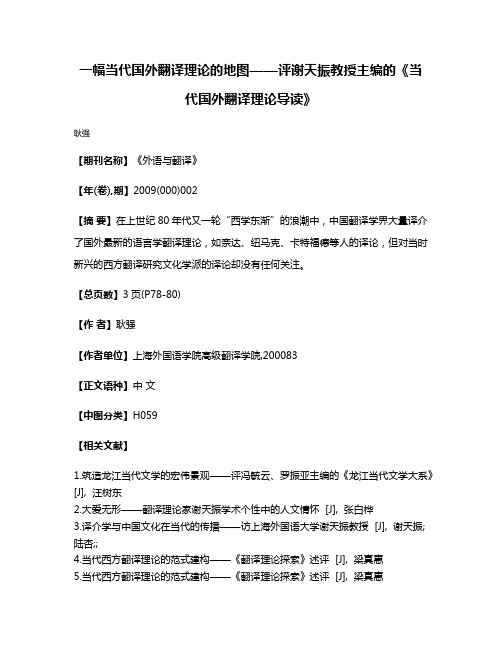
一幅当代国外翻译理论的地图——评谢天振教授主编的《当
代国外翻译理论导读》
耿强
【期刊名称】《外语与翻译》
【年(卷),期】2009(000)002
【摘要】在上世纪80年代又一轮“西学东渐”的浪潮中,中国翻译学界大量译介了国外最新的语言学翻译理论,如奈达、纽马克、卡特福德等人的译论,但对当时新兴的西方翻译研究文化学派的译论却没有任何关注。
【总页数】3页(P78-80)
【作者】耿强
【作者单位】上海外国语学院高级翻译学院,200083
【正文语种】中文
【中图分类】H059
【相关文献】
1.筑造龙江当代文学的宏伟景观——评冯毓云、罗振亚主编的《龙江当代文学大系》[J], 汪树东
2.大爱无形——翻译理论家谢天振学术个性中的人文情怀 [J], 张白桦
3.译介学与中国文化在当代的传播——访上海外国语大学谢天振教授 [J], 谢天振;陆杏;;
4.当代西方翻译理论的范式建构——《翻译理论探索》述评 [J], 梁真惠
5.当代西方翻译理论的范式建构——《翻译理论探索》述评 [J], 梁真惠
因版权原因,仅展示原文概要,查看原文内容请购买。
2019年当代美国翻译理论1
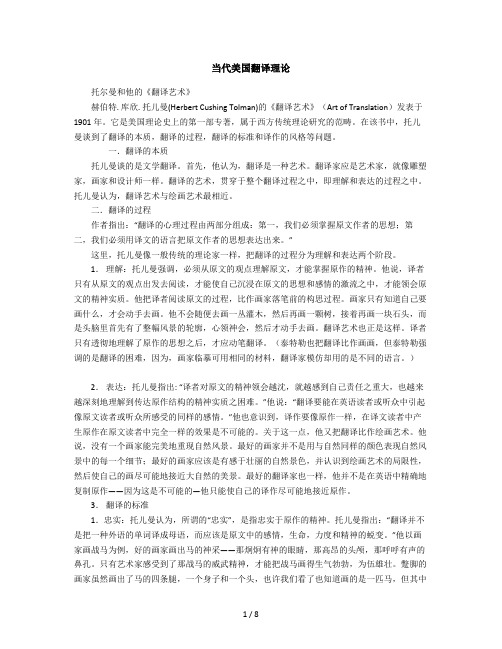
当代美国翻译理论托尔曼和他的《翻译艺术》赫伯特. 库欣. 托儿曼(Herbert Cushing Tolman)的《翻译艺术》(Art of Translation)发表于1901年。
它是美国理论史上的第一部专著,属于西方传统理论研究的范畴。
在该书中,托儿曼谈到了翻译的本质,翻译的过程,翻译的标准和译作的风格等问题。
一.翻译的本质托儿曼谈的是文学翻译。
首先,他认为,翻译是一种艺术。
翻译家应是艺术家,就像雕塑家,画家和设计师一样。
翻译的艺术,贯穿于整个翻译过程之中,即理解和表达的过程之中。
托儿曼认为,翻译艺术与绘画艺术最相近。
二.翻译的过程作者指出:“翻译的心理过程由两部分组成:第一,我们必须掌握原文作者的思想;第二,我们必须用译文的语言把原文作者的思想表达出来。
”这里,托儿曼像一般传统的理论家一样,把翻译的过程分为理解和表达两个阶段。
1.理解:托儿曼强调,必须从原文的观点理解原文,才能掌握原作的精神。
他说,译者只有从原文的观点出发去阅读,才能使自己沉浸在原文的思想和感情的激流之中,才能领会原文的精神实质。
他把译者阅读原文的过程,比作画家落笔前的构思过程。
画家只有知道自己要画什么,才会动手去画。
他不会随便去画一丛灌木,然后再画一颗树,接着再画一块石头,而是头脑里首先有了整幅风景的轮廓,心领神会,然后才动手去画。
翻译艺术也正是这样。
译者只有透彻地理解了原作的思想之后,才应动笔翻译。
(泰特勒也把翻译比作画画,但泰特勒强调的是翻译的困难,因为,画家临摹可用相同的材料,翻译家模仿却用的是不同的语言。
)2.表达:托儿曼指出: “译者对原文的精神领会越沈,就越感到自己责任之重大,也越来越深刻地理解到传达原作结构的精神实质之困难。
”他说:“翻译要能在英语读者或听众中引起像原文读者或听众所感受的同样的感情。
”他也意识到,译作要像原作一样,在译文读者中产生原作在原文读者中完全一样的效果是不可能的。
关于这一点,他又把翻译比作绘画艺术。
- 1、下载文档前请自行甄别文档内容的完整性,平台不提供额外的编辑、内容补充、找答案等附加服务。
- 2、"仅部分预览"的文档,不可在线预览部分如存在完整性等问题,可反馈申请退款(可完整预览的文档不适用该条件!)。
- 3、如文档侵犯您的权益,请联系客服反馈,我们会尽快为您处理(人工客服工作时间:9:00-18:30)。
1罗曼·雅科布逊
2彼得·纽马克交际翻译与语义翻译(Ⅱ)
3约翰·卡特福德论翻译转换
4尤金·奈达论对等原则
5 巴兹尔·哈蒂姆互文介入:利用翻译中缺省语篇的理论体系
6玛丽·斯奈尔—霍恩比翻译:一种跨文化活动
第二章阐释学派翻译理论
1乔治·斯坦纳阐释的步骤
2安托瓦纳·贝尔曼翻译及对异的考验
第三章功能学派翻译理论
3凯瑟琳娜·莱丝翻译的抉择:类型、体裁及文本的个性
4汉斯·弗米尔翻译行为中的目的与委任
5克里斯汀娜·诺德目的、忠诚及翻译中的惯例
第四章文化学派翻译理论
12 詹姆斯·霍尔姆斯翻译学的名与实
13 伊塔玛·埃文—佐哈翻译文学在文学多元系统中的地位
14 吉迪恩·图里描述性翻译研究的理论基础
15 安德烈·勒菲弗尔大胆妈妈的黄瓜:文学理论中的文本、系统和折射
16 苏珊·巴斯奈特文化研究的翻译转向
17 西奥·赫曼斯翻译研究及其新范式
18 瓦尔特·本雅明译者的任务
19 雅克·德里达巴别塔之旅
20.保罗·德曼评本雅明的《译者的任务》
21.劳伦斯·韦努蒂文化身份的塑造
第六章女性主义翻译理论
22.雪莉·西蒙翻译理论中的性别化立场
23.劳丽·钱伯伦性别与翻译的隐喻
24.巴巴拉·格达德女性主义话语/翻译的理论化
25.冯·弗罗托女性主义翻译理论批评
第七章后殖民翻译理论
26.道格拉斯·罗宾逊后殖民研究与翻译研究
27.特佳斯维妮·尼南贾纳翻译的定位
28.盖亚特里·斯皮瓦克翻译的政治
29.埃尔斯·维埃拉解放卡利班们——论食人说与哈罗德·德·坎波斯的超越/越界性创造诗学
第八章苏东学派翻译理论
30.安德烈·费奥多罗夫翻译理论的任务
31.吉维·加切奇拉泽文学翻译中的创造性原则
32.吉里·列维翻译是一个作选择的过程
33.安娜·丽洛娃翻译研究的范畴
6Roman Jakobson论翻译的语言学问题“On Linguistic Aspects
of Translation”
布拉格语言学派创始人罗曼·雅科布逊1959年发表的《论翻译的语言学问题》首先将语言学、符号学引进了翻译学,他把语言分为“语内翻译(Intralingual Translation)、语际翻译(Interlingual Translation) 和符际翻译(Intersemiotic Translation)”(三分法理论)。
